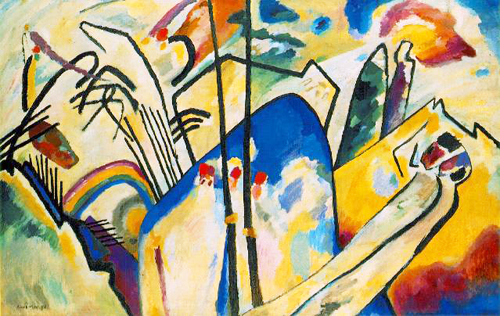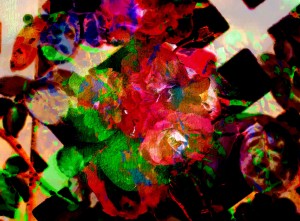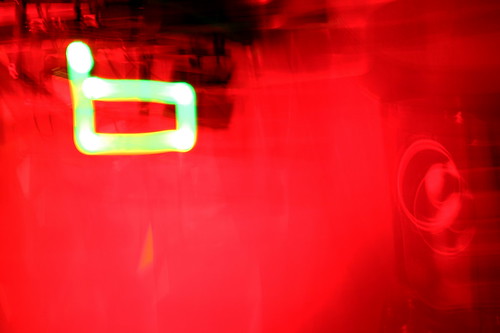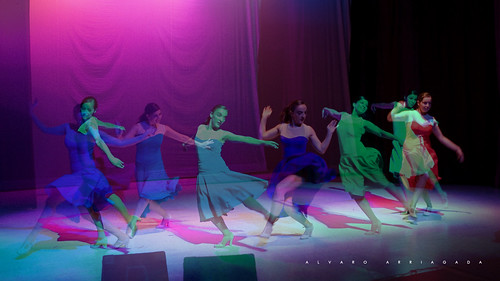
Advancements in neural imaging technology have shed light on one of the most fascinating phenomena: synesthesia. Commonly referred to as a mixing of the senses, synesthesia takes many forms. A smell may arouse a sight, a texture an aroma, or as in its most popular and documented form a sound yielding a sight. Composers may use their vivid, colorful imagination to guide their pen. Musicians may use this deep sensory connection to aid in memorization and expression. What is most interesting is that, structurally, there is nothing different between a synesthetes’ brain and your own (assuming rainbows don’t spring from your headphones). The grey areas around the definition of synesthesia are wide. Some define synesthesia as being a phenomenon that presents itself from birth, perhaps to disqualify those that have intentionally learned associations. Referring specifically to colored hearing, some specify that the concurrent presents itself to the open eye; that is, on top of the existing atmosphere (Moseley, 2010). Yet further, some scientists hypothesize that all infants exhibit synesthetic behavior (Hubbard, 2007). There are seemingly limitless varieties of sensory crossover that are possible, but for the purposes of this discussion, sound/music as the inducer, and color/images as the concurrent, will be the focus. Becoming familiar with theories of why synesthetic experiences occur strengthens understanding of our brain. Coupled with rich experience with art we can start to draw our own personal sensory connections.
[accordion multiopen=”true”]
[toggle title=”Historical Footing in Arts and Science”]

Before diving into modern neuroscience it is useful to know some early cases, theories, and origins of synesthesia. The word comes from the Greek syn meaning together, and aesthesis meaning perception. Approximately 1890 is when the term began to be used: 1889 appearance in Century Dictionary, 1890 disseminated at Conference of Physiological Psychology, 1892 Jules Millet’s thesis on audition colorée (Lorusso & Porro, 2010). However, scientists have been trying to put their finger on this interrelationship of the senses for far longer. Pythagoras aimed to assign a color to each note of the musical scale in the sixth century B.C. (Lorusso & Porro, 2010). In the late 17th century John Locke, in his Essay Concerning Human Understanding (1689), tells of a blind man who through diligent study has begun to understand colors. When prompted to describe scarlet, he replies, “it was like the sound of a trumpet.” And in 1664 Newton started to discover what light actually is, and separate it into the seven hues of the prism (curiously corresponding to the seven notes in a scale.) There are many other less scientific writings, mostly by artists (Scrjabin, Kandinsky, Goethe, Baudelaire, Rimbaud) which draw connections between sound, color and scent (Lorusso & Porro, 2010). Think of the phenomenon as a greater unity of artistic inspiration. The best art is fully fleshed in taste and feel, wrought with emotion and shrouded in grace. Do any works of art jump out at you with this visceral feel? Are you familiar with some work by synesthetes and understand the sensory connections they make?
[/toggle]
[toggle title=”Scientific Hypotheses”]

There are two leading theories as to what synesthesia actually is, in terms of a physical process: reduced feedback inhibition and cross-activation (Hubbard, 2007). The area of the brain that processes color is adjacent to the area which recognizes graphemes or phonemes (letters and sound bits, respectively). Scientists supporting the cross-activation model theorize that synesthetes’ brains have connections between these regions which are retained into adulthood (“reduced pruning” of prenatal pathways). They have even located the white matter highway that shares the signal. For an explanation of white matter versus grey matter, and further attributes of the musical brain visit Kelly’s Blog. Reduced feedback inhibition refers to feedback onto other sectors of the sensory cortex when a stimulus enters. In a normal non-synesthetic brain, a signal enters, and neurotransmitters in the form of inhibitors prevent the signal from affecting the parts of the brain that are not coded for the stimulus. Perhaps stimuli enter our sensory cortex and light up all sections. We register the ones that are meaningful or essential. As we mature we narrow our perception of the outside world, focusing on necessity, the most immediate, vital mode of the stimulus. There is evidence to support both theories and hybrids of the hypotheses exist as well.
A 2013 study using the most advanced neural imaging technology localizes the white-matter pathway connecting the visual and auditory areas. Those scientists, Zamm, Schlaug, Eagleman, and Loui (2013) support the ‘hyperconnectivity-hyperbinding’ model of synesthesia. The white matter highway that shares the sensory information is located on the V4 area of the sensory cortex (Zamm et al, 2013). Research on the similarities of synesthesia and the effects of LSD seem to support theories of disinhibited feedback, as that is essentially what the drug does, flooding the brain with neurotransmitters reducing inhibition (Hubbard, 2007). An article by Jamie Ward (2004) documents a case-study that draws attention to the importance of emotion in synesthetic responses. The individual in the study sees color in response to hearing names and other words. The concurrents are more vivid and consistent when the individual feels strongly about the inducer (names of people they know, emotional words.) What model of synesthesia seems most likely to you? To what extent is synesthesia useful or productive? Does accepting a broad definition of synesthesia allow more people creative license?
[/toggle]
[toggle title=”Synesthesia as Nature”]

The image above is very basic display of how vision and sound are related. If you had to assign the sound “bouba” to one and “kiki” to the other, which would receive which name? Odds are the orange spiky shape received the more sharp, angular sound of kiki. Bouba goes to the darker, rounder shape. What is displayed here is not synesthesia, but the innate human inclination toward it. In the bouba/kiki example all that is required is that we connect the dots between the sound and the icon. Synesthesia simply requires the presentation of a personal, consistent sensory experience while experiencing another. Speech is representative of the world we live in, and, in general, seeks to emulate it in a clear way. Music has the power to bring to life emotion through complex organizations of sound. We know that there are twelve notes within an octave, often seven steps in a scale. Some synesthetes experience a specific color for each individual note. Alternatively, the concurrent may be due to tonality or harmony: a wavering fully diminished chord versus a resolute root position major triad (octave in the bass) versus the joy behind tears of a major seventh chord. Sometimes the visuals correspond to a sounds’ timbre or its tone (technically this is due to the sounds’ overtone characteristics, but that’s a whole other discussion). Like John Locke described, perhaps a trumpet is scarlet, a cello deep forest green, French horn as royal blue. The examples are arbitrary. What matters is that they are consistent and meaningful.
[/toggle]
[toggle title=”E-motion in the Minds’ I”]
Keeping in mind Ward’s case-study, Emotionally Mediated Synesthesia, know that the composer feels something about the music they write. Try to identify which emotions the music (or art) rouses in you. Do you believe these are the same emotions the composer is working in? What elements are interacting together to represent this affect? Once we start to ask these fundamental questions about music or painting or poetry or dance (the list goes on) not only do we become familiar with the basic forces that interact across all art, we learn about ourselves. Perhaps then all we must do is color our own emotions: green with envy at something new, blue with lonely solitude as the cloudless sky over the sea, red with rage like a fire that consumes, purple with pride and physical pleasure. Emotions, like colors (like the scales and modes of music) are not absolute or terraced. They exist on a spectrum where an end leads to a new beginning. If you’d like, please share your meaningful experiences with art and emotion.

[/toggle]
[toggle title=”References”]

Hubbard, E. (2007). Neurophysiology of synesthesia. Current Psychiatry Reports, 9:193-199.
DOI: http://dx.doi.org/10.1007/s11920-007-0018-6
Ward, J. (2004). Emotionally mediated synaesthesia. Cognitive Neuropsychology, 21:761-772. University College, London UK.
DOI: http://dx.doi.org/10.1080/02643290342000393
Zamm, A., Schlaug, G., Eagleman, D.M. & Loui, P. (2013). Pathways to seeing music: Enhanced structural connectivity in colored-music synesthesia. NeuroImage, 74:359-366
DOI: http://dx.doi.org/10.1016/j.neuroimage.2013.02.024
Lorusso, L. & Porro, A. (2010) Coloured-hearing synaesthesia in nineteenth-century Italy. Imperial College School of Medicine, UK.
DOI: http://dx.doi.org/10.1142/9781848162693_0015
Moseley, I. Crossed wired: synaesthetic responses to music. Imperial College Press, 2010.
DOI: http://dx.doi.org/10.1142/9781848162693_0016
Images were found by use of Creative Commons.
[/toggle]
[/accordion]



Tastes often remind me of experiences or art–for instance cheese lentil casserole will always be associated with Wes Anderson’s telling of Fantastic Mr. Fox. I tasted a red cinnamon candy the other day that reminded me of Christmas at age 5 and the cookies bearing these sweets which I hadn’t tasted since then.
Without knowing much about the physiological or psychological inner workings of synesthesia I would venture to say it is somewhat of a spectrum. It seems to me most people have senses that are tied together but only a select sensual few might hear colors or see sounds in a highly synesthesic way. Important and noted in your piece was the placebo crowd of sensory seekers of whom I might be placed who relish in the artistic bliss of mixing senses and mastering the sensual soundtrack of their world.
What writing on synesthesia might you recommend for someone who wants to learn more?
Mark! You are such a colorful person; absolutely love the cheese lentil casserole example. A spectrum is probably the best single word to describe synesthesia. You have excellent instincts.
As far as further reading I think there are two ways to go: scientific or artistic. As far as the research goes the three studies I’ve referenced are recent, well varied, and technically informative. Also, the Oliver Sacks book Kendra mentioned above I’m sure is a colorful, accessible read about the inner and outer workings of the musical mind which might bridge scientific and artistic nicely. On the artistic side I think just getting a good knowledge base of amazing art is best. Go outside your comfort zone and get to know the greats of every genre. Even artists that don’t claim to be synesthetic are still inspired from the exterior/sensory world and apply their touch to art. Ah, there’s so much here; would love to have a conversation about beauty sometime soon.
Yeah I’m flat out jealous/mystified by people who have it. Although after quizzing our boy DG about it for hours one night, I realized it’s similar to knowing another language in that you can’t really describe your attribution of colors to someone who can’t even imagine it. If I asked a Spanish speaker why their syntax is different than ours, their answer would be, well, that’s how it is. Either way, I’d love to listen to and feel music in color.
It can certainly be a baffling or, like you say, mystifying thing, but I’d really like to believe that we all have this “power.” I can certainly get visuals if I’m listening to a great piece of music and close my eyes. I think the language analogy works well. When a person is translating what they intend to say word for word from their own language to another, while maybe understandable, is awkward and lacks proper grammar. But as they become more and more familiar with the language they stop needing to word for word translate. Eventually the word order and phrasing become natural. I’m sure we’ve all heard someone tell the story about the first time they dreamed in a foreign language. Try the closing your eyes thing, maybe to a Mahler symphony 😉 I’d be interested to hear what, if anything happens.
Very interesting! I am a visual artist, and experienced a form of synethesia from birth with the brain assigning colors to certain visual markers (ie. letters – “R” is purple, “S” is red and numbers – “2” is green, “1” is blue, etc.). At 22, I had a cardiac arrest, my brain was without oxygen for a significant amount of time and I was resuscitated with a defibrillator/breathing-machine. Afterwards, my learning style changed dramatically and music basically took over everything. It was after this event that I suddenly began to experience intense colors associated with music (different insurgents, tones). I f first happened when I was listening to a student composition being performed live by the Berklee student orchestra – just incredible. I was fascinated by the section on this phenomenon in Oliver Sack’s book “Musicophilia: Tales of Music and the Brain” and enjoyed learning more about the history of its study here. Great job ~kendra
Thanks so much for sharing; I feel lucky to’ve received a comment from a synesthete right off the bat! I would be curious to know if you experience color from listening to (recorded) music via headphones/speakers or if it is just a live music thing. I’d be in the symphony hall around the clock if that were the case. I found this album the other night and listened to it as I fell asleep: Terry Riley’s “A Rainbow in Curved Air” https://www.youtube.com/watch?v=hy3W-3HPMWg I think the name suggests some sort of synesthetic inspiration.
I feel that your use the word “tone” is enlightening. That encompasses a few aspects of sound. In my opinion it can be appropriately used in reference to/in place of timbre, expressive meaning, and also the full sound (attack, sustain, decay all implied). Also, an intensity or shade to whatever is ‘going on.’ Again, thanks for the read. Be well.